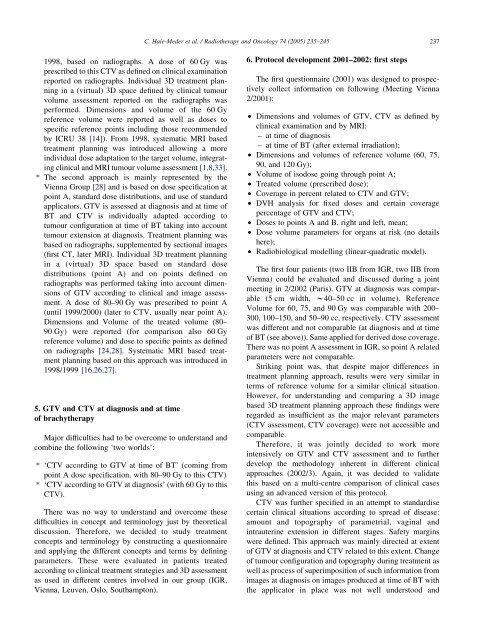Recommendations from Gynaecological (GYN) GEC-ESTRO ...
Recommendations from Gynaecological (GYN) GEC-ESTRO ...
Recommendations from Gynaecological (GYN) GEC-ESTRO ...
Create successful ePaper yourself
Turn your PDF publications into a flip-book with our unique Google optimized e-Paper software.
1998, based on radiographs. A dose of 60 Gy was<br />
prescribed to this CTV as defined on clinical examination<br />
reported on radiographs. Individual 3D treatment planning<br />
in a (virtual) 3D space defined by clinical tumour<br />
volume assessment reported on the radiographs was<br />
performed. Dimensions and volume of the 60 Gy<br />
reference volume were reported as well as doses to<br />
specific reference points including those recommended<br />
by ICRU 38 [14]). From 1998, systematic MRI based<br />
treatment planning was introduced allowing a more<br />
individual dose adaptation to the target volume, integrating<br />
clinical and MRI tumour volume assessment [1,8,33].<br />
* The second approach is mainly represented by the<br />
Vienna Group [28] and is based on dose specification at<br />
point A, standard dose distributions, and use of standard<br />
applicators. GTV is assessed at diagnosis and at time of<br />
BT and CTV is individually adapted according to<br />
tumour configuration at time of BT taking into account<br />
tumour extension at diagnosis. Treatment planning was<br />
based on radiographs, supplemented by sectional images<br />
(first CT, later MRI). Individual 3D treatment planning<br />
in a (virtual) 3D space based on standard dose<br />
distributions (point A) and on points defined on<br />
radiographs was performed taking into account dimensions<br />
of GTV according to clinical and image assessment.<br />
A dose of 80–90 Gy was prescribed to point A<br />
(until 1999/2000) (later to CTV, usually near point A).<br />
Dimensions and Volume of the treated volume (80–<br />
90 Gy) were reported (for comparison also 60 Gy<br />
reference volume) and dose to specific points as defined<br />
on radiographs [24,28]. Systematic MRI based treatment<br />
planning based on this approach was introduced in<br />
1998/1999 [16,26,27].<br />
5. GTV and CTV at diagnosis and at time<br />
of brachytherapy<br />
Major difficulties had to be overcome to understand and<br />
combine the following ‘two worlds’:<br />
* ‘CTV according to GTV at time of BT’ (coming <strong>from</strong><br />
point A dose specification, with 80–90 Gy to this CTV)<br />
* ‘CTV according to GTV at diagnosis’ (with 60 Gy to this<br />
CTV).<br />
There was no way to understand and overcome these<br />
difficulties in concept and terminology just by theoretical<br />
discussion. Therefore, we decided to study treatment<br />
concepts and terminology by constructing a questionnaire<br />
and applying the different concepts and terms by defining<br />
parameters. These were evaluated in patients treated<br />
according to clinical treatment strategies and 3D assessment<br />
as used in different centres involved in our group (IGR,<br />
Vienna, Leuven, Oslo, Southampton).<br />
C. Haie-Meder et al. / Radiotherapy and Oncology 74 (2005) 235–245 237<br />
6. Protocol development 2001–2002: first steps<br />
The first questionnaire (2001) was designed to prospectively<br />
collect information on following (Meeting Vienna<br />
2/2001):<br />
† Dimensions and volumes of GTV, CTV as defined by<br />
clinical examination and by MRI:<br />
– at time of diagnosis<br />
– at time of BT (after external irradiation);<br />
† Dimensions and volumes of reference volume (60, 75,<br />
90, and 120 Gy);<br />
† Volume of isodose going through point A;<br />
† Treated volume (prescribed dose);<br />
† Coverage in percent related to CTV and GTV;<br />
† DVH analysis for fixed doses and certain coverage<br />
percentage of GTV and CTV;<br />
† Doses to points A and B, right and left, mean;<br />
† Dose volume parameters for organs at risk (no details<br />
here);<br />
† Radiobiological modelling (linear-quadratic model).<br />
The first four patients (two IIB <strong>from</strong> IGR, two IIB <strong>from</strong><br />
Vienna) could be evaluated and discussed during a joint<br />
meeting in 2/2002 (Paris). GTV at diagnosis was comparable<br />
(5 cm width, w40–50 cc in volume). Reference<br />
Volume for 60, 75, and 90 Gy was comparable with 200–<br />
300, 100–150, and 50–90 cc, respectively. CTV assessment<br />
was different and not comparable (at diagnosis and at time<br />
of BT (see above)). Same applied for derived dose coverage.<br />
There was no point A assessment in IGR, so point A related<br />
parameters were not comparable.<br />
Striking point was, that despite major differences in<br />
treatment planning approach, results were very similar in<br />
terms of reference volume for a similar clinical situation.<br />
However, for understanding and comparing a 3D image<br />
based 3D treatment planning approach these findings were<br />
regarded as insufficient as the major relevant parameters<br />
(CTV assessment, CTV coverage) were not accessible and<br />
comparable.<br />
Therefore, it was jointly decided to work more<br />
intensively on GTV and CTV assessment and to further<br />
develop the methodology inherent in different clinical<br />
approaches (2002/3). Again, it was decided to validate<br />
this based on a multi-centre comparison of clinical cases<br />
using an advanced version of this protocol.<br />
CTV was further specified in an attempt to standardise<br />
certain clinical situations according to spread of disease:<br />
amount and topography of parametrial, vaginal and<br />
intrauterine extension in different stages. Safety margins<br />
were defined. This approach was mainly directed at extent<br />
of GTV at diagnosis and CTV related to this extent. Change<br />
of tumour configuration and topography during treatment as<br />
well as process of superimposition of such information <strong>from</strong><br />
images at diagnosis on images produced at time of BT with<br />
the applicator in place was not well understood and




